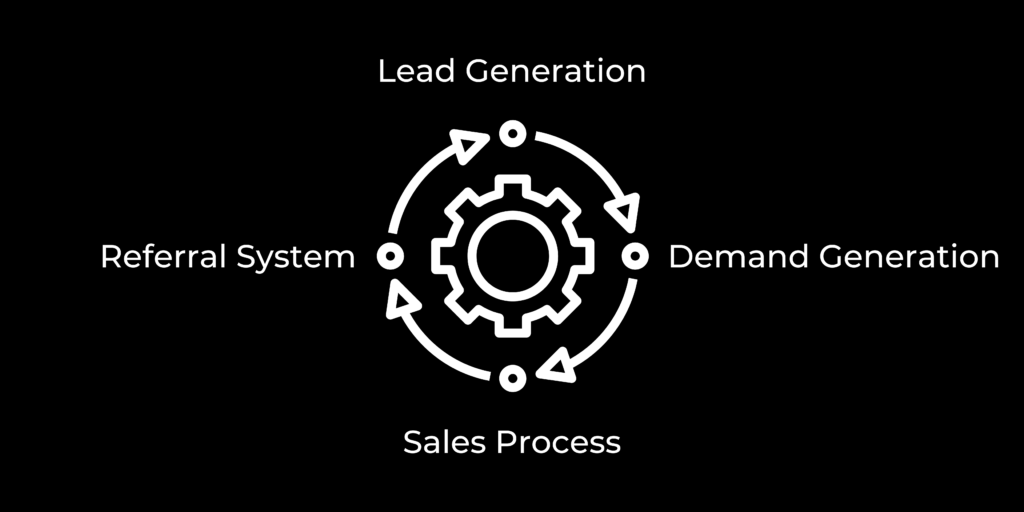Wondering how to sell consulting services? This article will discuss four systems every consultant must master to sell their services right.
Every consultant aims for a big fat paycheque out of a client’s pocket. But very few know that landing that cheque requires more of a strategy than expertise. Without a reliable action plan, a firm grip over the market or deep industry knowledge helps very little. And this is common across the spectrum – whether you are a seasoned consultant, a boutique consulting firm, or a first-time player. So, what should you do?
Selling consulting services is hard because you are not selling a product that your potential customers or clients can touch and feel. The entire engagement is like building a relationship that purely relies on mutual trust and your functional expertise.
Before we talk about the systems, let us get some basics out of the way.
If you have walked through our earlier posts, we have been quite forthright about three things:
- Discovering your niche and becoming a thought leader
- Understanding your target audience
- Focusing on content to build trust and authority
Discover your niche. Prepare yourself to answer – why should clients approach you when they have a market full of options? Having a niche or expertise helps you stand out. It distinguishes you from your competitors. Your brand positioning and expertise in a topic, industry, or location should resonate with your target market.
Do a competitor analysis to see where you stand. Narrow your focus to cut through your competition. But don’t overdo this. For instance, if you are looking at clients in the healthcare industry, specifically dealing in medical devices, further narrowing down your industry focus can hamstring you.
Understand your audience. Make informed decisions based on in-depth analysis. We are sure you will accumulate basic information, but don’t stop there. Go beyond basic. What problems are your prospective clients facing? What future aspirations do they have? What’s holding them back? Peek into their digital presence. What platforms are they active on? How do they view content?
Remember, your potential clients are living, breathing individuals with specific tastes, preferences, and personalities. Even though they are linked to business entities, they operate from the core of their emotions.
Focus on your content. Like you would do some research on your prospective client, they would do the same when you approach them. They would look into your website. Go through your content. If at all, they don’t find it interesting and valuable – the chances of them giving you business may drop. Set the impression right! Take an inventory of the content your prospects may consume at each stage of their journey. Look for ways you can optimize your content. Reflect on how you can make your content more exciting and valuable.
4 systems to master to sell your consulting services successfully
Let’s dive in!
How to sell consulting services? Here is a sneak peek of the 4 systems to master.

Outreach and Lead Generation
After all the research, you know by now what your ideal client looks like and what they need. It’s time to craft a compelling value proposition. Be sure to include two essential points:
- What value will you bring to the table? (What are your strengths?)
- Why should clients choose you? (What makes you stand out?)
Quality lead generation can take months. This is the time when most consultants give up or make hasty decisions. Choose the right clients by investing enough time in outreach and lead generation. Do not let your marketing efforts fall flat.
Now, you need to bring your value proposition to your target audience. The two most popular mediums to reach your audience are:
- Emails
- Social Media
This article will cover email marketing and Linked outreach as ways to reach your audience, as most of our readers are in the B2B space. Choose the social media channel depending on where your audience spends time.
Email Marketing

One of the most effective ways of lead generation is Email Marketing.
A cold email is a message that is sent to an individual or company with the hope of starting a new relationship.
The first step in cold email outreach is to find a relevant contact. You can subscribe to a third-party database, like Zoominfo and Hunter, to find your prospects. While this might be the fastest way to find prospects, it comes with risks. Contacting prospects without their consent can be detrimental to your reputation. You also run the risk of being blacklisted by your email service provider.
Therefore, your best bet is to create your own email list with an opt-in email form on your website. You can use gated content to lure your readers into subscribing to your email list. Remember, if you’re gating content, you’re offering something valuable in return, such as market research, business insights, tips, or hacks. If you want to know how to generate leads with gated content – here are the 7 steps to follow.
Building an email list from scratch will take time, but it is an essential component of your email marketing system.
Also, here are some tips for building an effective email marketing system.
- Use Lead Scoring to sort out quality leads. Lead scoring is a technique used to prioritize leads. It assigns a score to each lead and ranks them in order of their importance. The scores are based on the lead’s interest in the company’s service, how much they have engaged with the company, and how close they are to converting into customers.
- Email automation tools can also help you with your lead-scoring system. Now, what is Email Automation? It is a way to reach the right people with the right messages. Email automation tools allow you to set rules and trigger emails based on actions taken by your prospect. If you are wondering where to tap the best email automation tool – Here are the 6 Best Email Marketing Automation Tools to look at.
- Write clear and concise emails to your clients – not too flashy or verbose. Use a simple template with well-spaced, concise wording. Highlight what’s necessary. Do not forget to add a CTA.
- And make sure your subject lines are eyeball-grabbing.
LinkedIn Outreach

The world has evolved. Technology has transformed every facet of how a business operates. Consumer behavior is now far more specific and complex –why are we making sales in an old way? Maybe it’s time we adapt. LinkedIn Outreach is another highly effective way to approach potential clients and build valuable relationships.
But why LinkedIn? Because nearly 800 million people across the globe access it for various business purposes, such as networking, recruitment, sales, learning, and business development…LinkedIn is a reservoir of opportunities.
Now, if you are considering using LinkedIn as we speak – here’s what your action plan should look like:
Search for new connections once a day. LI Sales Navigator is the best tool for doing this. Use Sales Navigator’s filters to quickly filter through LinkedIn’s member base by function, industry, seniority, location, and other relevant factors.
- Identify and reach out to prospects daily (the new LinkedIn limit allows you to send approximately 100 connection requests a week). Invest time in your in-mails and messages. Write meaningful content rather than copy-pasted messages. Think of approaching those first with whom you have something in common to talk about.
- Keep three things in mind when writing an in–mail: 1) Start socially, 2) Pitch quickly, and 3) Include a call-to-action. Start with what you share in common with your prospective client. What caught your attention? Then, talk about a potential issue that the client may be facing. How can you help? Then, clearly outline what the client should do next.
- Don’t be elaborate. Divide your pitch into simple paragraphs. Do some professional digging to build that in-person connection with the prospect.
Dear X,
Congratulations on being promoted to Partner at ABC.
What an incredible LinkedIn profile with 20 years of rich industry experience. I have also provided advisory services in the medical device and pharma sector for 15 years. No wonder we have much in common.
Allow me to introduce myself. I am the Founder of XYZ Consulting. We have built our expertise in providing financial advice to C-Suite executives.
I would like to connect with you and see if we can collaborate on any project. May we connect and see?
Demand Generation (Build Trust and Authority)

Some of you may think, why this hoopla around authority? Why have we talked so much about it in our earlier posts? And mentioning it again. Well, the truth is – that it is an invaluable asset for consultants who want to be taken seriously by prospective clients.
New players are entering the consulting market every second. This robust expansion is also instigating tremendous competition. So, if you want to be at the top of the mind of your clients – up your content game. Great content establishes authority. And authority breeds trust. Clients tend to rely more on those who know their turf well.
If you want to command authority – build content.
But if you are wondering, just any content would do – NO! Craft top-of-the-pile content.
- One that displays your expertise.
- One that helps you gain a foothold.
- One that crowns you as an undoubted leader.
- One that shows how well-read and diverse you are in your perspectives.
Most popular content types for consulting business
Dabble into data-rich case studies, opinion pieces, thought leadership articles, or whitepapers. Share industry-specific insights. Publish content with the primary aim of cementing relationships with your audience.
Webinars
Webinars and other speaking engagements are great promotional events. They help convince potential clients that you have a strong hold on your niche. They drive in high traffic because of their in-person feel. Your audience can see you and connect with you better. The more popular you become, the more your connections increase and fuel your demand generation efforts.
Whitepapers
A white paper is an in-depth article that intends to provide a solution to a complex problem. Whitepapers do wonders in showcasing your expertise and authority in your niche. They are informative and persuasive documents to influence decision-making.
Thought Leadership Articles
Thought leadership articles are usually long-form content focusing on the author’s opinion or expertise on a given topic. They also help in positioning the company in its niche. The most important thing when writing such articles is ensuring they are informative, original, fact-based, and engaging. This will help you build credibility and trust with your readers.
Podcasts
Podcasts are content goldmines that drive high engagement and loyal listenership. They are an excellent way to reach out to your target audience and connect with them on an emotional level. Podcasts have been around since the early 2000s but have recently become popular. The number of podcasts available has increased dramatically, and so has the number of listeners. Many marketers have started using podcasts in their campaigns because of their effectiveness in generating leads. And you can repurpose them into other formats, such as blogs or videos. The Deloitte Global Insights podcast series is an excellent example for consulting firms.
Here’s the thing – The more credible your brand becomes, the more leads you generate organically. Also, consistency is the key. Even the best business strategies fail without dedication. You will notice – as you stay consistent with your content marketing efforts, you will build a loyal readership.
Case Study: How Publicis Sapient Positioned Itself as a Thought Leader by Publishing Breakthrough content
Integration of digital technology into different business areas has skyrocketed. Clients spend a considerable amount of time online and engage on digital platforms. They expect to have a smooth and enjoyable experience. Convenience wins over cost. And so, it has become imperative for consultants to offer a seamless experience if they wish to succeed. The Digital Life Index Report by Publicis Sapient is one such attempt. The global market research report is based on an exhaustive survey done across 12 countries. It explores people’s behavior, satisfaction, and expectations as they go digital. It shows how retail, financial services, and healthcare industries are reeling from this massive change.
Publicis Sapient has always been very innovative as far as content is concerned. What’s so clever about a survey report? Apart from the fact that it serves valuable strategies and diverse perspectives, Publicis transformed the survey insights into a full-fledged playlist too. Yes! The Digital Life Index playlist spreads across nine episodes on their’ HOW Channel.’ It dives into how digital technology shapes customers’ futures. Each episode starts with a problem and ends with a meaningful solution.
The ‘HOW Channel’ by Publicis Sapient is an excellent display of authority and credibility. It is a pandemic baby and was created to compellingly reach a broad audience base. The HOW series also won the Silver Award in the ‘Best use of Thought Leadership’ category at the B2B Elevation Awards 2021.
Sales Process

Have you ever wondered how selling and marketing share a symbiotic relationship? They both impact each other. If you remove one from the other, both will fall flat.
Whether you are an employee pitching an idea to your boss, an entrepreneur trying to entice an investor to invest in your business, or a parent cajoling your kid to go to school, we are all trying to influence human behavior. Trying to move the other, selling something. To sell is human.
As a consultant, you need to be resilient and persistent. The b2b sales cycle is a long process. It involves discussions with multiple decision-makers.
You need a system to churn required presentations during the sales process efficiently. Your pitch decks and proposals will be tailored to your client’s needs, but you don’t have to start from scratch every time.
Here are a few tips from the treasure trove to help you quickly create proposals.
- Start by creating a skeleton or an outline that will remain constant across proposals.
- Create a slide for each question that you anticipate from your prospects
- Create slides that showcase your credibility – such as successful case studies, profiles of team members, testimonials, etc.
- Have versions of your framework or your solution ready so that they can be easily plugged into a proposal
- Use templates and technology to speed up the creation process and cut your research time significantly. Thinks of tools like Canva and Think cell to design your presentations; Grammarly to edit your documents; Semrush, Google trends, and alerts for competitor analysis and industry insights.
Referral System

Is there a better way to get surefire business than from referrals that come through happy and satisfied clients? Client referrals are an advantage in many ways, such as they advance through the sales process faster, have healthier margins, greater loyalty, and an added layer of trust.
Yet, it’s disappointing that so many consultants leave this crop unharvested. Or, at best, engage passively. Why?
When you have worked so hard to deliver excellent service – why get a cold foot here? If you have a problem asking your existing clients to put in a word for you, here it is – a no-fail approach to help you secure an ongoing stream of referrals.
- Make sure to consider ‘Referral System’ as an integral part of your overall business strategy. You must take it as seriously. Don’t be shy in telling them you are looking for new opportunities. Be persuasive and persistent about it.
- Make the system attractive and appealing. Free dinners, concert tickets, or a free service may help your clients feel more valued and connected. And, since you offer them benefits beyond the usual range of service, they would happily give you free referrals.
- Manage ‘Acquiring Referrals’ like a process. Start with identifying who can provide you with quality referrals (think of clients in an influencing position and with a broad network). Would they be willing to put a word for you? If yes, the next step is to initiate the conversation. Request your current clients for an introduction. If you hear back from the referral, remember that besides representing your firm, you also represent the client. So, write back with valuable insight and expertise that will be useful to the referral – irrespective of whether they do business with you. If the conversation moves ahead – time to share your sample work. This will allow the referral to be more confident of you.
- Exceed expectations. Once you secure a client through referral – Go above and beyond to serve her. Not just through your service but also by proving to be an indispensable resource for them. Give them enough reasons to talk about your credibility in their network.
- Apply the power of compounding. Invest your time in networking regularly. Build relationships. It seems like no gainer initially, but that’s where the power of compounding comes in. These little steps that you take from the start will yield a big fruit at the end.
- Leverage LinkedIn. LinkedIn’s Advanced People Search feature makes it easy to turn up qualified second-degree connections your clients can introduce you to. To get started, click the search bar at the top of the page and then select ‘People’ from the drop-down menu. You can filter your search by second-degree connections and additional specifics like industry, title, keywords, and location to create a list of potential referral opportunities. This will help you find an ideal referral candidate to bring up to your client.
Here is a quick recap for you to get going
How to sell consulting services?
- For a great start – think of outreach and lead generation as ways to find and reach out to your prospects. Email Marketing and Social media marketing are great ways to reach your prospects.
- Content Marketing is critical here. If you want to be taken seriously – establish Authority and Credibility. Position yourself as a trustworthy thought leader or an expert in the market. Indulge in thought leadership articles, speaking engagements, virtual interactive sessions, blogs, and podcasts.
- The more credible your brand becomes, the more leads you generate organically. Also, consistency is the key. Even the best business strategies only succeed with dedication.
- Up your sales game – Set up a straightforward sales process. You need a system to churn required presentations during the sales process efficiently.
- Think of it from a long-term standpoint. Invest in relationship-building from the start. Stay connected to your clients.
- Build a robust referral system – Client referrals are advantageous in many ways. They advance through the sales process faster, have healthier margins, greater loyalty, and an added layer of trust. Integrate client referrals as part of the business strategy.
We have discussed the four systems critical to selling a consulting service in detail.
But here’s a thought –
Sell your ideas every day and sell them hard. There is no one way or right time to do this. If you believe in yourself and your ideas, talk about them passionately to your clients, prospects, peers, friends, and acquaintances. You never know what turns up when. But we can assure you – the above four systems will surely help you be organized and scale up fast!
Ready to build your content marketing strategy? Start by reading this article.
Powerful Marketing Strategy for Consulting Firms to Get Results
Reading Time: 12 minutes Marketing strategy for consulting firms must have a long-term vision and should be about building the following three things: Visibility: You need to be an



